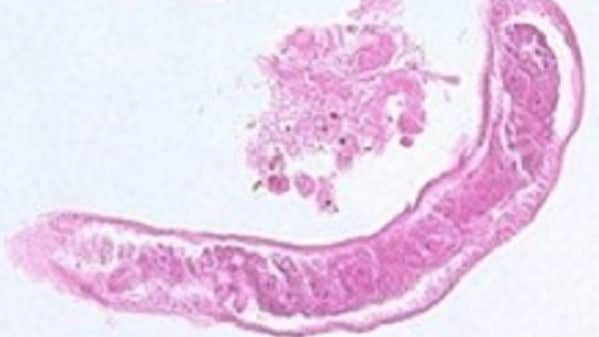Key points
- Drugs are available to treat capillariasis.
- Mebendazole is the treatment of choice for infection.
- Albendazole is an alternative drug option for infection.
- Consider safety precautions of medications in different populations.

Treatment options
Mebendazole is the treatment of choice capillariasis infection. Albendazole is an alternative drug option.
Drug
Dosage
Notes
Mebendazole*
Adults and children: 200 mg orally twice a day for 20 days
Oral mebendazole is available for human use in the United States.
Albendazole*
Adults and children: 400 mg orally once a day for 10 days
Oral albendazole is available for human use in the United States.
Albendazole should be taken with food; a fatty meal increases oral bioavailability.
*Not FDA-approved for this indication.
This information is provided as an informational resource for licensed health care providers as guidance only. It is not intended as a substitute for professional judgment.
Care precautions
Treatment in Pregnancy
Mebendazole is a pregnancy category C drug. Data on the use of mebendazole in pregnant women are limited. The available evidence suggests no difference in congenital anomalies in the children of women treated with mebendazole during mass drug administration (MDA) campaigns compared with those who were not. In MDA campaigns in countries where soil-transmitted helminths are common, World Health Organization (WHO) has determined that the benefits of treatment outweigh the risks and WHO allows use of mebendazole in the 2nd and 3rd trimesters of pregnancy. However, in a pregnant woman infected with a soil-transmitted helminth, balance the risks of treatment for the fetus with the risks of disease progression in the woman in the absence of treatment.
Pregnancy Category C: Either studies in animals have revealed adverse effects on the fetus (teratogenic or embryocidal, or other) plus there are no controlled studies in women, or studies in women and animals are not available. Prescribe mebendazole only if the potential benefits to the woman justify the potential risks to the fetus.
Treatment during lactation
Mebendazole is minimally excreted in breast milk. WHO classifies mebendazole as compatible with breastfeeding and allows its use in lactating women.
Treatment in pediatric patients
The safety of mebendazole in children is unclear. There are limited data in children under 2 years old. The WHO Model List of Essential Medicines for Children lists mebendazole as an intestinal antihelminthic medicine that can be used for children older than 2 years of age.
Treatment in Pregnancy
Albendazole is a pregnancy category C drug. There are limited data on the use of albendazole in pregnant women. The available evidence suggests no difference in congenital abnormalities in the children of women accidentally treated with albendazole during mass drug administration (MDA) campaigns compared with those who were not. In MDA campaigns for which the World Health Organization (WHO) has determined that the benefits of treatment outweigh the risks, WHO allows use of albendazole in the 2nd and 3rd trimesters of pregnancy. However, healthcare providers should balance the risks of treatment for the fetus with the risks of disease progression in the woman in the absence of treatment.
Pregnancy Category C: Either studies in animals have revealed adverse effects on the fetus (teratogenic or embryocidal, or other) plus there are no controlled studies in women, or studies in women and animals are not available. Prescribe albendazole only if the potential benefits to the woman justify the potential risks to the fetus.
Treatment during lactation
Albendazole is minimally excreted in human milk. WHO has concluded that a single oral dose of albendazole can be given to lactating women.
Treatment in pediatric patients
The safety of albendazole in children less than 6 years old is not certain. Studies of the use of albendazole in children as young as one year old suggest that it is safe. According to WHO guidelines for MDA campaigns, children as young as one year of age (able to safely swallow tablets) can take albendazole. These campaigns have treated many children under six years old with albendazole, albeit at a reduced dose.
References
References
- Li CD, Yang HL, Wang Y. Capillaria hepatica in China. World J Gastroenterol. 2010 Feb 14;16(6):698-702.
- Drugs for Parasitic Infections. Treatment Guidelines from the Medical Letter. Vol 8 (Suppl), 2010. The Medical Letter, Inc., New Rochelle, NY.
- Cañete R, Escobedo AA, Almirall P, González ME, Brito K, Cimerman S. Mebendazole in parasitic infections other than those caused by soil-transmitted helminths. Trans R Soc Trop Med Hyg 2009;103:437-42.
- Moore TA. Agents active against parasites and pneumocystis , Table 44-1-General recommendations for the treatment of parasitic infections. In: Mandell GL, Bennett JE, Dolin R, Eds., Mandell, Douglas, and Bennett’s Principles and Practice of Infectious Diseases, 7th Ed, Churchill Livingston/Elsevier, Philadelphia, PA, 2009.
- Soukhathammavong P, Sayasone S, Harimanana AN et al. Three cases of intestinal capillariasis in Lao People’s Democratic Republic. Am J Trop Med Hyg 2008;Nov;79(5):735-8.
- Guerrant RL, Walker DH, Weller PF (eds). Tropical Infectious Diseases: Principles, Pathogens, and Practice, 2nd Edition. Philidelphia 2006, pp 1242-1244.
- Bair MJ, Hwang KP, Wang TE et al. Clinical features of human intestinal capillariasis in Taiwan. World J Gastroenterol 2004 Aug 15;10(16):2391
